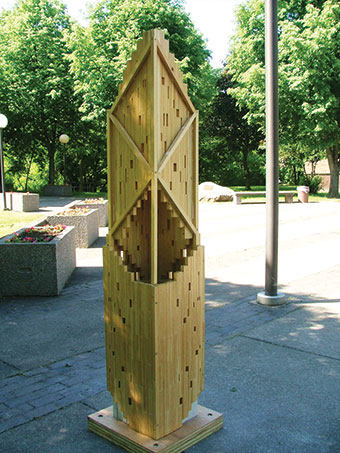On The Edges Again
by Jack Foran


A sculpture competition at Artpark
Seven sculptural works selected for Artpark’s Edges II competition are currently on display at the park. They’re worth the trek to Lewiston.
D. W. Martin’s sculpture is called Mega Hertz and is a kind of animated version of an electrical power transmission pylon that looks a little like a horse, a little like an idol image for some ancient moon cult. What would be the head of the horse or idol is a crescent moon form, with the horns tied together with a bar element. So that the horns could be positive and negative electrical poles, and the tie element an electrical arc. The piece is one of a number of works by this artist transforming such mundane objects of ordinary visual experience as electrical grid pylons, as a means of transforming our way of visual perception in general, the artist says on a placard accompanying the work.
Ellen Steinfeld’s piece is called Circus and is reminiscent of Alexander Calder’s circus sculptures, but in an abstraction, whereas Calder’s sculptures were more figurative, more actually toy-like. The zany, capricious welded metal construction includes hoops and rings and balls evocative of juggling and acrobatic arts, and a zig-zag strip that might represent a clown costume neck ruff.
Coral Lambert’s metal sculpture is intended to capture the metalworking process, with particular reference to the molten state of constantly changing form, the transitional state between one thing and another. The forms the artist inevitably does capture are huge rumpled metal sheets of irregular textures and dimensions, some hemispheres, like the bubbles on boiling liquid metal, and some coil-construction cone forms hand-fashioned from metal cooled to a modeling clay condition. Of metal in molten and subsequent states during the working process, Lambert says, “I regard it as a living material as it breathes, oxidizes, and grows, emerging from the mould raw and elemental, as if raised from the earth depths.”

Scott Bye’s jumble of triangular and rectangular forms is reminiscent of the art of minimalist/conceptualist Sol LeWitt and is about how simplicity becomes complexity, and the nature of sculpture. On the accompanying placard, the artist refers to DNA, the structure of life, and its algorithm of infinite self-replication, which we only understand (more or less) through understanding the DNA structure. The essence of sculpture is three-dimensionality, but the three-dimensional components are themselves composed of two-dimensional forms (the triangles and rectangles) in infinite self-replication, encompassing rollover to the third dimension. In this piece, a cradle base of adjacent solid geometry triangles (five sides, two triangles and three rectangles) supports a profusion of similar forms exploding upward into what appears to be chaos, but a chaos of all the same simple, basic, comprehensible unit.
Robert Garlow’s handsome wood and concrete tower construction is called Embedded Process. It is about how concrete poured into a wooden temporary holding structure—essentially a mold—retains the exact form of the mold, in negative, from the interstitial crevice lines between the wood planks or boards to the grain of the wood. Construction in concrete as a kind of instant fossilization process. The memory of materials.
David J. Winter’s piece is called Twisted Sisters. It consists of ribbons and curlicues of metal the artist selected from the scrap heap as too beautiful or interesting to be allowed to formally disappear in the recycle meltdown crucible. This elegant welded construction has a sense of blithe and carefree spinning off into the ozone (or what’s left of the ozone).
Brett Coppins’ sculpture is called Requiem for Lost Love, a huge ceramic abstraction. Or possibly representational? Of some sort of secret passageway, blocked, barred, made inaccessible? Clearly it was a painful experience. We only hope Brett is over it now and has moved on with his life.
The Edges II competition is a somewhat tardy follow-up to Edges I, which occurred three years ago. The competition was conceived as an annual event, but major cuts in Artpark’s funding from the state in 2009 and 2010 forced postponement for two years. Let’s hope there will be an Edges III.
The sculptures are on view at Artpark through September 16.
blog comments powered by Disqus|
Issue Navigation> Issue Index > v10n35 (Fall Arts Issue, week of Thursday, September 1) > On The Edges Again This Week's Issue • Artvoice Daily • Artvoice TV • Events Calendar • Classifieds |









 Current Issue
Current Issue